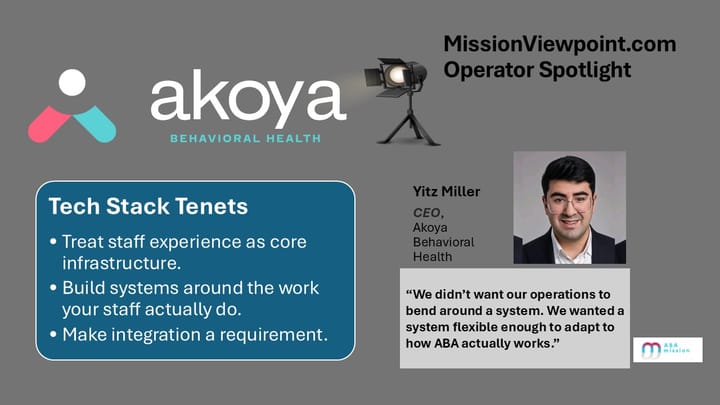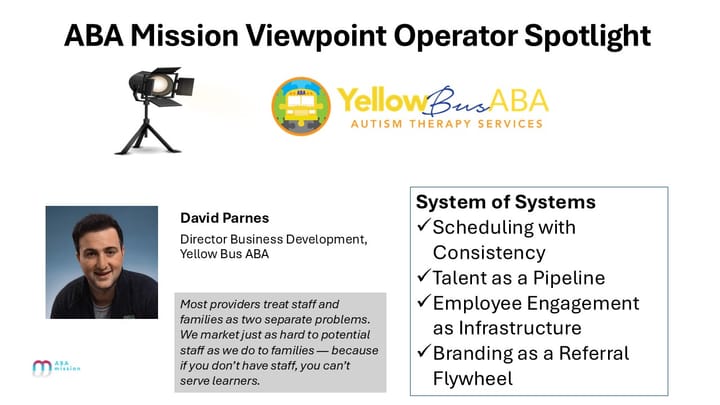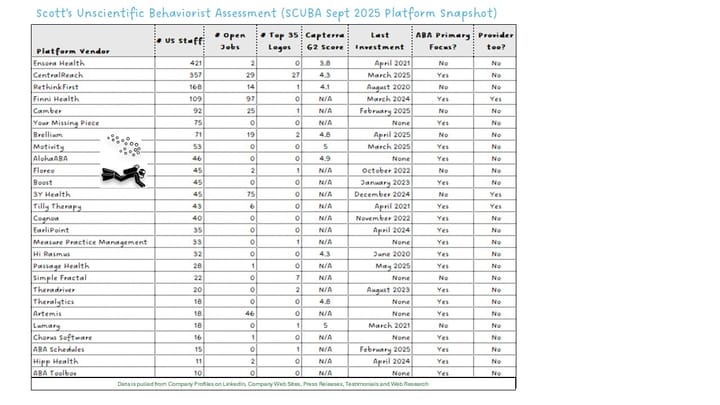Operator Spotlight: 360 Behavioral Health and the Extensible ABA Ecosystem

Healthcare companies in general have been laggards in adopting Salesforce. That’s often because incumbent, expansive legacy Practice Management/EHR systems — think Epic, Cerner, or in the case of ABA, CentralReach — are already deeply embedded into critical operations.
360 Behavioral Health selected Lumary (built on Salesforce) as their operational platform for its secure, scalable architecture that supports flexibility, rapid integrations, and real-time insights. Paired with a clinician-favorite data platform, Hi Rasmus, the choice reflects a focus on practical interoperability and frontline usability.
Shifting to an Ecosystem Mindset
This wasn’t just a system swap. It was a move toward an ecosystem approach — using Lumary as a configurable backbone, integrated with purpose-built tools that work for both clinicians and admin teams.
Hi Rasmus, in particular, has been a hit with clinicians. It manages all clinical work time (billable and non-billable) with a UX they find intuitive. For admin users, that same data flows directly into Lumary for scheduling, claims, and other operational needs.
Differentiation in Action
With this architecture, 360 can do more than replicate old workflows.
Forms management starts with Lumary’s base templates and can be adapted for payor-specific needs — from school paperwork to specialized funding requirements — without heavy coding.
These adaptations also mean intake and referral processes now run in a single, connected flow — from an inquiry on the website, to a referral from a diagnostician or nonprofit partner, all the way to an active client record. What once involved separate CRM or intake systems is now visible in one place, with the ability to trigger bulk follow-ups via SMS or email.
Lumary’s platform brings added communication layers like automated SMS updates, or tailored workflows for non-clinical functions such as managing referrals with diagnosticians or non-profits.
Integration has also been a win. 360 connected Lumary to UKG for payroll and HR, pulling time and clinical data from Hi Rasmus. That same data could also be integrated with a standalone compliance management tool if needed. And API connections, once a major pain point, are now far simpler to implement.
Lean IT, Big Reach
360 operates with a lean IT footprint despite its size.
Much of the integration and light configuration work can be handled internally by a Salesforce champion who understands both the platform and the provider’s operational needs. When something more advanced is required, subject matter experts (SMEs) work directly with Lumary to make changes that often get rolled into the base product for other clients.
Hi Rasmus plays a big role here too — not just as a clinician tool, but as a bulk automation engine for managing work time, team meetings, and other non-billable activity. For clinicians, it’s their daily workspace. For admin teams, it’s a reliable data source driving operational decisions and revenue cycle efficiency.
Dashboards that once took days or weeks to compile manually are now live and accessible by every operational manager. Whether tracking cancellations for immediate backfill or monitoring timely note completion, leaders can act on same-day data rather than reviewing last month’s performance.
“Lumary has leveled up our flexibility and connectivity. Along with Hi Rasmus, we can build exactly what our teams need, integrate faster, and keep our focus on delivering quality care — not fighting with technology.” - Kate Princi, CEO 360 Behavioral Health

A Model for Other Large ABA Providers
For operationally mature ABA providers — especially those with aligned leadership and well-defined internal processes — 360 Behavioral Health’s approach illustrates how building around a configurable, Salesforce-based platform like Lumary can unlock meaningful possibilities.
By integrating clinician-preferred tools like Hi Rasmus, alongside other favored solutions, into a scalable framework, providers can implement a model that fits their workflows and supports strategic growth with much more flexibility than ever before.
The result isn’t just better technology — it could be a stronger, more adaptable foundation for long-term impact, agility, and differentiation in the ABA community.



